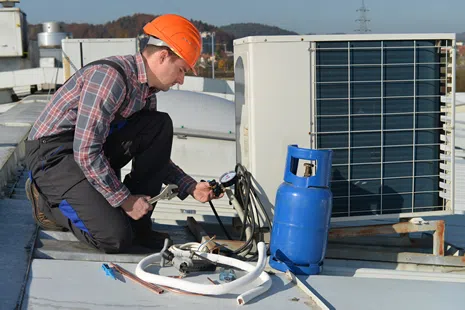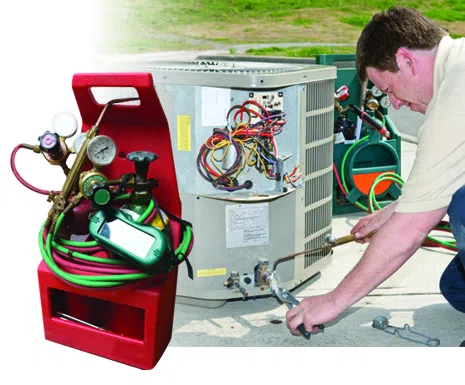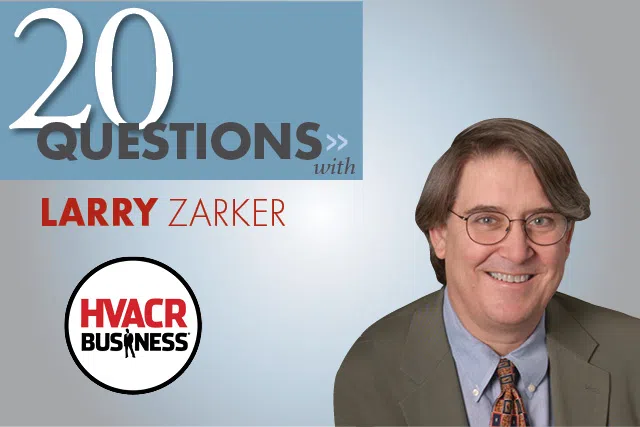Remember what happened with Indoor Air Quality (IAQ ) services such as duct cleaning? Even though HVACR contractors are clearly the most knowledgeable providers of duct maintenance, it wasn’t long before any business with a vacuum system started offering duct cleaning when consumers realized what lurked inside their vents. Now energy optimization is on the minds of commercial and residential customers. If heating-cooling-and-ventilation contractors don’t respond, other businesses will.
In an effort to answer the many questions and concerns that our readers have about building performance contracting and home performance contracting, HVACR Business has invited several experts to contribute articles on these topics in 2012. This is the first of several articles that will be packaged and archived together on HVACRBusiness.com.
In this article, Bill Spohn, CEO and co-owner, TruTech Tools; and Jim Bergmann, CTO and co-owner, TruTech Tools, respond to some common questions that contractors have about building performance contracting and home performance contracting.
What is building performance contracting?
Building performance contracting (BPC) — in its simplest sense — means performing standard service and contracting work (construction, insulation, windows, HVAC, electrical/lighting, etc.) in existing and new buildings while planning and coordinating how all of these components and systems will interact with each other throughout all stages of the job, and ultimately, while in use by the customer. This also means fixing performance issues in existing buildings as well as eliminating performance issues in new construction.
Why would anyone pay for this?
Because when contractors approach heating, cooling, and ventilation — and the building the equipment is operating in as a unified system instead of discrete systems — their customers save on energy costs as they enjoy increased comfort and improved IAQ. Additionally, this apporach is based on science and precision measurement, so both contractors and customers can have confidence in results. In its 2005 report "Investigation of the Impact of Commercial Building Envelope Airtightness on HVAC Energy Use,” the National Institute of Standards and Technology stated:
“Despite common assumptions, measurements have shown that typical U.S. commercial buildings are not particularly airtight. Past simulation studies have shown that commercial building envelope leakage can result in significant heating and cooling loads. Predicted potential annual heating and energy cost savings ranged from 2% to 36% with the smallest savings occurring in the cooling-dominated climates of Phoenix and Miami.”
What is home performance contracting?
Home performance contracting (HPC) is the subset of BPC that deals with homes.
Often, contractors engaged strictly in HPC describe themselves as BPCs, but this is not technically correct. Unique standards exist for HPC, and additional standards are being developed for multi-family and commercial buildings.
Furthermore, BPCs work with high-performance building standards, processes, and techniques that address health and safety, building durability, energy-efficiency, and comfort issues. They apply building science in concert with advanced — yet readily available — measuring equipment. A contractor can certainly provide both BPC and HPC, but they are not the same.
Depending upon their business mod- el and training/certification, BPC/HPC contractors provide a variety of services, including: air sealing, insulation, energy modeling, Energy Star homes, HERS ratings, heating and A/C installation or tune-ups, blower-door testing, infrared/ thermal imaging, air balancing, and duct-leakage testing.
Why should I get into this business?
BPC/HPC is an extension of the “care-related” services that you already provide to your customers. And without a doubt, many of your current customers are interested in one or more challenges that BPC addresses: health and safety, building durability, energy-efficiency, and comfort. Well-managed, this new service area should mean new, profitable revenues from existing customers with whom you have an established, trusting relationship.
According to the website of GreenHomes America, one of the larger franchise providers of complete HPC packages for contractors:
“Home performance solutions will be the fastest-growing segment of the resi- dential marketplace over the next decade and beyond. Why? Because America must reduce its energy consumption, and improving the energy efficiency of America’s 75 million single-family homes is the most cost-effective way to accomplish it. City, state, and federal incentives continue to roll-out across the country to encourage homeowners to make comprehensive energy upgrades that will reduce their energy use by 30%, 40%, and even 50% or more. Are you prepared to capitalize on this movement?”
Am I already in this business?
You may be if you and your staff have thought “out of the box” when it comes to other building/house systems interactions with the “box” (HVAC equipment). Incorporating something as familiar as the International Fuel Gas Code (e.g., Appendix D Recommended Procedure For Safety Inspection of an Existing Appliance Installation); or ACCA Manual J (Residential Load Calculation, Manual S (Residential Equipment Selection); and Manual D (Residential Duct Systems) calculations into your processes can achieve correct system sizing with the consideration of many key factors other than simply reading the nameplate of the existing unit.
These key factors involve:
- local climate,
- size, shape, and orientation of the house,
insulation levels, - window area, location, and type,
- air infiltration rate,
- the number and ages of occupants,
- occupant comfort preferences; and,
the types and efficiencies of heat producing lights and major home appliances.
BPC techniques actually give you the means to measure many of the factors you would otherwise assume or estimate in a load calculation.
You may also have heard of/use the Air Conditioning Contractors of America Quality Installation Standard (ACCA-QI), which helps to ensure the performance of HVAC systems. According to this standard:
“A significant market opportunity for improving the quality of HVAC equipment installations and service involves raising the awareness of consumers and building owners/operators about the benefits provided by professional contractors following industry-recognized quality installation practices (e.g., correct equipment selection, installation, and commissioning). Building owners/operators and residential consumers need to be inforned of the links between comfort, humidity levels, utility bills, and indoor air quality with a proper HVAC system design and installation . . . Customers who select contractors that promote QI and high-performance HVAC equipment enjoy enhanced comfort, reduced energy usage, improved occupant productivity, and enhanced occupant safety.”
Who are the leading contracting companies already in the business?
In HPC, you will find franchise-based GreenHomes America with 13 locations in six states owned by the large facilities-management mastermind LINC Group (now part of ABM Company); and WellHome with 14 locations in 12 states — a division of Masco Home Services, which is part of the multibillion-dollar mammoth Masco Corp. Honeywell is pulling together groups of contractors into this field via www.weatherizationpro.net as is ZeroDraft (nearly 65 distributors/dealers to date across the United States and Canada); and smaller examples are Isaac Heating in Upstate New York; Hobaica Services in Phoenix; AirRite Air Conditioning in Fort Worth, Texas; Tag Mechanical in Syracuse, N.Y.; and Cropp Metcalfe in Fairfax, Va.
Who are the leading manufacturers already in the business?
Manufacturing companies in the business break down into several categories:
Installed equipment: All the major HVAC equipment manufacturers have products that can be considered “performance products.”
Materials and supplies: The basic materials (ductwork, fittings, etc.) are ones with which you are familiar, except perhaps sealants, air barriers, and insulation from the like of Johns-Manville, Owens Corning, Certainteed, Knauf, Tremco, Icynene, BASF, Dow Chemical, and many others.
Test and measurement: The Energy Conservatory, Test Products International, Fieldpiece, and RetroTech are the leaders in duct and building pressure-testing systems. Testo, Fluke, Milwaukee Tool and FLIR are among the well-known brands in thermal imaging cameras. Testo, Bacharach, Sensit and UEi are some of the vendors that produce the combustion, carbon monoxide, and gas leak-detection equipment. A host of other vendors and tools round out the mix.
In many ways it is more about the ap- plication of “standard” products with a new way of thinking. As with different types of cuisine, the chef/cook (technician) can use the same basic food ingredients (the equipment) incorporating their individual talents, training and skills with the aid of their culinary tools (test and measurement equipment), and varied experience putting together different recipes (installations) that lead to strikingly different flavors (performance).
How do I make money at this?
Are you making money now? The same principles apply to making money in this business; but you need to under- stand what it takes to get into the business — technical understanding, equipment and staffing, management and staff commitment, profitable pricing models, and a marketing plan to reach target customers. Your technicians are already servicing existing homes and commercial properties. Perhaps they are overlooking potential opportunities to solve building performance issues and in turn generate additional revenue for your company.
HVAC contractors are very well positioned to grow in this field as they already have an existing customer base and solid reputation. You may simply need to educate your staff to look for BPC issues and opportunities to solve for clients.
In addition, BPC is a great way to level the seasonality in the HVAC business because this type of work is not an emergency call and can fill holes in work schedules.
This can also be leveraged as a competitive advantage — a unique service. Many BPC jobs result in the need for customers to downsize equipment with the installed cost offset by the forward-looking savings on operating expenses. It is also a means to lower liabilities, via the “test in and test out” mentality fostered in BPC, especially with regards to testing the interactions of the building with equipment.
So much of a company’s success will depend on how well the philosophies of BPC are embraced at the management level.
What will it cost me to get into this business?
Depending upon your level of service and the type of test equipment you already own, you can set up one auditing crew for between $3,000 and $12,000 in diagnostic equipment, and $2,000 to $6,000 in training. You will have additional costs if you move into extensive air sealing, insulation, or windows, if these are not already part of your business. However, process training will be required to use some of this equipment in a new (BPC) light.
What training is required for me, my technicians, and my other staff?
You need to train/develop or hire an in-house building-sciences expert. Your expert can set up your auditing and work crews and provide the in-house training required for the rest of your staff to ap- preciate this new area of business. Your expert should have a solid technical background, some teaching skills, and be BPI or RESNET certified or working on it. The book A Contractor’s Guide to Home Performance is a wonderful starting point for owners and employees. Be patient. Your new expert may need time to practice and gain the requisite field experience to effectively implement this line of business for you.
Keep in mind expectations and qualities of an effective BPC/HPC are set, and you need to gear your business for these. A good resource to review is the Energy Star website, www.energystar.org.
Do you need to be certified and who certifies?
Just like HVAC, BPC is an industry of standards, although the BPC standards are still in development. Almost no legal requirements exist to be certified to do the work (with the exception of Babylon, N.Y.), yet certification provides trust to the customer via third-party affirmation of your training and skills.
The Building Performance Institute (www.BPI.org) and the Residential Energy Services Network (www.RESNET.us) are two key bodies you need to be aware of. Both are headed for ANSI recognition of their standards.
Note that many of these standards reference HVAC standards and are developed by individuals that work in or have experience or strong roots in the HVAC field. What companies offer training in HpC/BpC?
Look for a training affiliate or provider on the BPI and RESNET websites. But all training is not created equally, and if the training promises are too good to be true, it should be avoided. BPI and RESNET continually work to improve the quality of training offered to be sure to deliver a better “product” to consumers in the BPC/HPC markets.
Is the government involved?
The EPA has been running the Energy Star for Homes (ES) programs for new homes since 1995 and Home Performance with Energy Star (HPwES) for existing homes since 2009. The ES program is currently in its third version, and the HPwES engages the market at many levels: program sponsors (utilities or state energy offices) in regions, as well as contractor partnership agreements and marketing to consumers via Home Energy Makeover contests.
How do i find out about govern- ment and private-sector rebates?
Locate the programs at the Database of State Incentives for Renewables and Efficiency DSIRE (www.dsireusa.org) or check with local utilities. A sub- scription service company GreenOhm (www.greenohm.com) provides rebate and incentive solutions to consumers for utilities, municipalities, counties, states, federal, retailers and manufacturers via a zip-code lookup.



